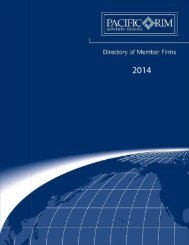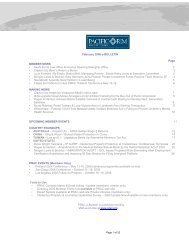A Guide to the Law of Securitisation in Australia - Clayton Utz
A Guide to the Law of Securitisation in Australia - Clayton Utz
A Guide to the Law of Securitisation in Australia - Clayton Utz
- No tags were found...
Create successful ePaper yourself
Turn your PDF publications into a flip-book with our unique Google optimized e-Paper software.
assess precisely <strong>the</strong> type <strong>of</strong> material that a court is likely <strong>to</strong>consider should be disclosed <strong>in</strong> a capital markets <strong>in</strong>formationmemorandum.To date <strong>the</strong>re has been no case law directly on this issue.The answer is likely <strong>to</strong> turn on a court’s assessment <strong>of</strong> <strong>the</strong>function and role <strong>of</strong> an <strong>in</strong>formation memorandum <strong>in</strong> <strong>the</strong><strong>in</strong>vestment process. Unfortunately, <strong>the</strong>re appear <strong>to</strong> be twoopposite views on this.The first is that <strong>in</strong>ves<strong>to</strong>rs typically do not have access, nor areprivy, <strong>to</strong> all <strong>in</strong>formation relat<strong>in</strong>g <strong>to</strong> <strong>the</strong> particular capital marketssecurities. An <strong>in</strong>formation memorandum, <strong>the</strong>refore, performs afunction similar <strong>to</strong> that <strong>of</strong> a prospectus by provid<strong>in</strong>g an <strong>in</strong>tend<strong>in</strong>g<strong>in</strong>ves<strong>to</strong>r with all material <strong>in</strong>formation necessary <strong>to</strong> make an<strong>in</strong>vestment decision. Accord<strong>in</strong>gly, <strong>the</strong> material that an <strong>in</strong>ves<strong>to</strong>rwould expect <strong>to</strong> be disclosed <strong>in</strong> an <strong>in</strong>formation memorandum issimilar <strong>to</strong> <strong>the</strong> standard set out <strong>in</strong> section 710 <strong>of</strong> <strong>the</strong> CorporationsAct, ie. all <strong>in</strong>formation that <strong>in</strong>ves<strong>to</strong>rs and <strong>the</strong>ir pr<strong>of</strong>essionaladvisers would reasonably require <strong>to</strong> make an <strong>in</strong>formedassessment <strong>of</strong> <strong>the</strong> issuer and <strong>the</strong> relevant securities.The contrary view is that those who prepare an <strong>in</strong>formationmemorandum are not <strong>in</strong>ves<strong>to</strong>rs. They cannot predict all <strong>the</strong><strong>in</strong>formation that would be relevant <strong>to</strong> an <strong>in</strong>vestment decision.While all due care may be taken <strong>to</strong> prepare an <strong>in</strong>formationmemorandum, <strong>the</strong>re is no guarantee that it conta<strong>in</strong>s all relevant<strong>in</strong>formation. It is <strong>the</strong> duty <strong>of</strong> each prospective <strong>in</strong>ves<strong>to</strong>r <strong>to</strong> satisfy<strong>the</strong>mselves on this front. If a prospective <strong>in</strong>ves<strong>to</strong>r fails <strong>to</strong>adequately protect its <strong>in</strong>terests, this should not lead <strong>to</strong> liabilityfor those who prepare an <strong>in</strong>formation memorandum.There is some merit <strong>in</strong> both views. On one hand, <strong>in</strong>ves<strong>to</strong>rsare largely dependent on <strong>the</strong> disclosures <strong>in</strong> an <strong>in</strong>formationmemorandum <strong>in</strong> mak<strong>in</strong>g <strong>the</strong>ir <strong>in</strong>vestment decisions. On <strong>the</strong> o<strong>the</strong>rhand, <strong>to</strong> require disclosures equivalent <strong>to</strong> a section 710 standardwould be <strong>to</strong> equate capital markets <strong>in</strong>ves<strong>to</strong>rs <strong>to</strong> members <strong>of</strong> <strong>the</strong>public; yet <strong>the</strong> present legislative scheme is founded on <strong>the</strong>assumption that sophisticated <strong>in</strong>ves<strong>to</strong>rs do not need <strong>the</strong>protection <strong>of</strong> prospectus legislation.The doubt regard<strong>in</strong>g <strong>the</strong> appropriate standard <strong>of</strong> disclosure <strong>in</strong> an<strong>in</strong>formation memorandum represents a major deficiency with <strong>the</strong>present situation. It creates a substantial uncerta<strong>in</strong>ty for those<strong>in</strong>volved <strong>in</strong> <strong>the</strong> preparation <strong>of</strong> an <strong>in</strong>formation memorandumregard<strong>in</strong>g <strong>the</strong> disclosures necessary <strong>to</strong> avoid liability for a breach<strong>of</strong> sections 1041H and 12DA(1).3.3.4 Inadvertent omissionsAno<strong>the</strong>r area <strong>of</strong> uncerta<strong>in</strong>ty <strong>in</strong> relation <strong>to</strong> omissions is whe<strong>the</strong>ran <strong>in</strong>advertent (as opposed <strong>to</strong> a deliberate) failure <strong>to</strong> disclosematerial <strong>in</strong> an <strong>in</strong>formation memorandum can breach sections1041H and 12DA(1).The expression “engag<strong>in</strong>g <strong>in</strong> conduct” is def<strong>in</strong>ed <strong>in</strong> section12BA(2) <strong>of</strong> <strong>the</strong> ASIC Act as, amongst o<strong>the</strong>r th<strong>in</strong>gs, “do<strong>in</strong>g orrefus<strong>in</strong>g <strong>to</strong> do any act”. The phrase “refus<strong>in</strong>g <strong>to</strong> do an act” isdef<strong>in</strong>ed <strong>to</strong> <strong>in</strong>clude “restra<strong>in</strong><strong>in</strong>g (o<strong>the</strong>rwise than <strong>in</strong>advertently)from do<strong>in</strong>g that act”. These def<strong>in</strong>itions are identical <strong>to</strong> those <strong>in</strong>section 4(2) <strong>of</strong> <strong>the</strong> TPA.The expression “engage <strong>in</strong> conduct” is def<strong>in</strong>ed <strong>in</strong> section 9(1) <strong>of</strong><strong>the</strong> Corporations Act as “<strong>to</strong> do an act or th<strong>in</strong>g or <strong>to</strong> omit <strong>to</strong>perform an act or th<strong>in</strong>g” (see also <strong>the</strong> def<strong>in</strong>ition <strong>of</strong> act <strong>in</strong> section9(1)). Importantly, unlike <strong>the</strong> correspond<strong>in</strong>g def<strong>in</strong>itions <strong>of</strong>engag<strong>in</strong>g <strong>in</strong> conduct under <strong>the</strong> ASIC Act and <strong>the</strong> TPA, <strong>the</strong>Corporations Act def<strong>in</strong>ition does not specifically exclude<strong>in</strong>advertent omissions.The exception <strong>in</strong> section 12BA(2) <strong>of</strong> <strong>the</strong> ASIC Act suggests thatconduct does not <strong>in</strong>clude an <strong>in</strong>advertent failure <strong>to</strong> do an act andthat a positive refusal <strong>to</strong> do an act is required before it can besaid that <strong>the</strong>re has been “conduct”. This l<strong>in</strong>e <strong>of</strong> reason<strong>in</strong>gsuggests that an <strong>in</strong>nocent omission from an <strong>in</strong>formationmemorandum will not lead <strong>to</strong> a breach <strong>of</strong> section 12DA.However, this approach is <strong>in</strong> tension with <strong>the</strong> well establishedpr<strong>in</strong>ciple that knowledge is not a necessary <strong>in</strong>gredient for abreach <strong>of</strong> section 52 (and presumably sections 12DA(1) and1041H). In Parkdale Cus<strong>to</strong>m Built Furniture Pty Limited v Puxu Pty.Limited (1982) 149 CLR 191, Chief Justice Gibbs stated:“There is noth<strong>in</strong>g <strong>in</strong> <strong>the</strong> section that would conf<strong>in</strong>e it <strong>to</strong> conductwhich was engaged <strong>in</strong> as a result <strong>of</strong> a failure <strong>to</strong> take reasonablecare. A corporation which has acted honestly and reasonably may<strong>the</strong>refore never<strong>the</strong>less be rendered liable <strong>to</strong> be restra<strong>in</strong>ed by<strong>in</strong>junction and <strong>to</strong> pay damages if its conduct has <strong>in</strong> fact misled ordeceived or is likely <strong>to</strong> mislead or deceive.”This approach was endorsed by <strong>the</strong> Full Federal Court <strong>in</strong> Fraser vNRMA Hold<strong>in</strong>gs:“... for <strong>the</strong> purposes <strong>of</strong> section 52, if by reason <strong>of</strong> what was saidand what was left unsaid <strong>the</strong> conduct <strong>of</strong> <strong>the</strong> corporation ismislead<strong>in</strong>g or deceptive or likely <strong>to</strong> mislead or deceive, acontravention would occur even if <strong>the</strong> corporation through itsdirec<strong>to</strong>rs and <strong>of</strong>ficers did not have knowledge <strong>of</strong> <strong>the</strong> undisclosedfacts which rendered <strong>the</strong> conduct <strong>in</strong> breach <strong>of</strong> section 52.”19






